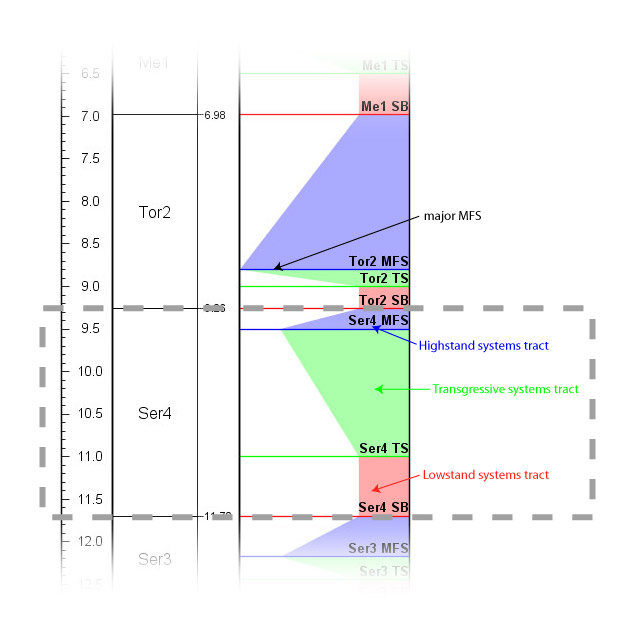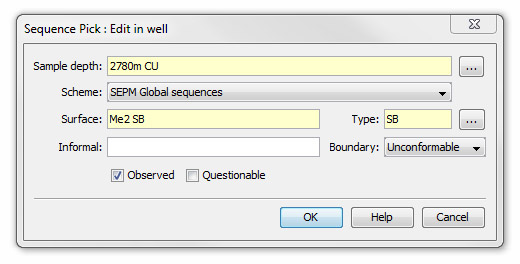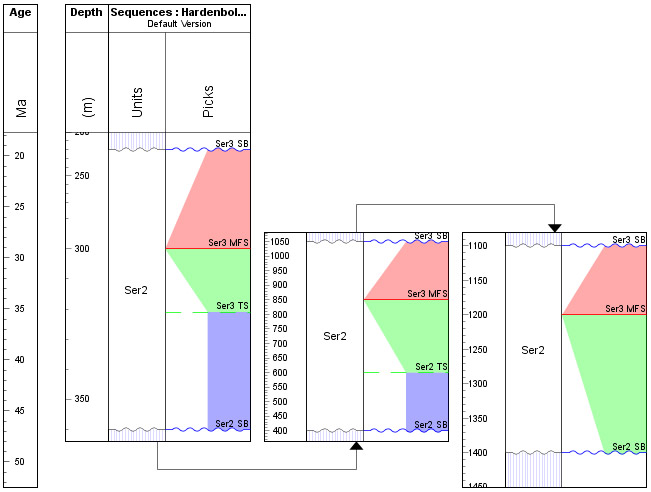Sequences in StrataBugs
This page describes the sequence stratigraphy model and terminology used in StrataBugs v2.
Sequence schemes
A sequence scheme defines a hierarchy of sequence units and surfaces. Sequence units may be defined in two hierarchy levels (Sequence and Subsequence).
Sequence units are bounded and subdivided by surfaces. Surfaces may be of type SB (sequence boundary or correlative conformity), TS (transgressive surface or maximum regressive surface) or MFS (maximum flooding surface). Regions between the surfaces are called systems tracts - highstand tracts (SB > MFS or MFS > MFS), transgressive tracts (MFS > TS or SB) and lowstand tracts (TS > SB or SB > SB).
For maximum flooding surfaces, the relative magnitude of base-level change is assigned as minor, medium or major.
Units and surfaces are related by their ages. It is important to define the ages so that units can be derived from surface picks on charts (see below). Sequence units are bounded by SB surfaces in a depositional (Valian) scheme, and MFs in a genetic (Galloway) scheme.
See the Stratigraphic Schemes dialog for more information about entering sequence schemes.

Sequence picks
In a well version you can record picks of surfaces from a sequence scheme. Sequence picks are always linked to a surface (i.e. you cannot have "informal" sequence picks in the same way as you can have informal intervals), but they can be given an informal name.
>> You can view, add or edit sequence picks:
- For one well in the Samples & Interpretations module, on the Interpretations tab;
- In the Schemes & Interpretations module, where you can manage sequence picks for a whole project.

Plotting sequence picks
The sequence picks panel derives sequence tracts from the order of picked surfaces. Highstand tracts (SB > MFS or MFS > MFS) show in red, transgressive tracts (MFS > TS or SB) in green and lowstand tracts (TS > SB or SB > SB) in blue. The order of the picks is determined, in order of preference by: 1) age, as defined by the depth/age curve; 2) TVD, as defined by the deviation survey; 3) drilled depth. Note that that the picked surfaces do not have to be part of the same sequence or be adjacent in the sequence scheme - only the surface type is used.
You can configure the system tracts colours from the StrataBugs control panel - Config | Misc Colours...
Sequence intervals are not recorded in the well, but they can be derived using the scheme. The surfaces are matched to intervals using their ages. Sequence intervals are bounded by 'sequence boundary' surfaces in a depositional scheme (Vail) scheme, and by 'maximum flooding' surfaces in a genetic (Galloway) scheme.

This example shows a sequence which is repeated within a reversed section (i.e. where the depth/age curves defines a region where age decreases with depth). Note that the surfaces are picked are picked in each of these sub-sections of the well.
In this simple correlation diagram, surfaces in two wells are related to the scheme. Well-1 has an unobserved pick of the Me2 sequence boundary at its top sample - the pick is not plotted but it is shown in the correlation and used to complete the Me1 interval.